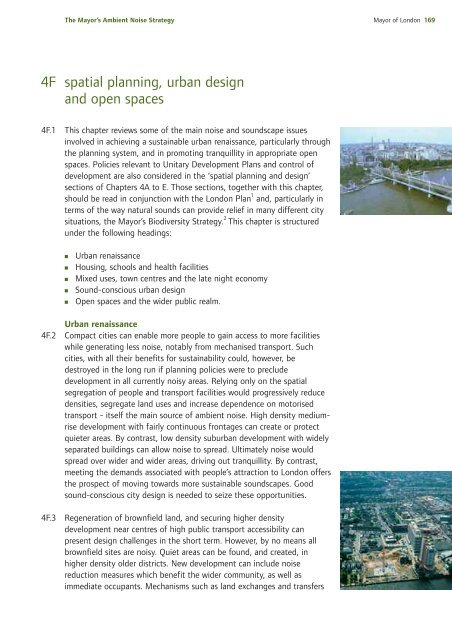The Mayor's Ambient Noise Strategy - Greater London Authority
The Mayor's Ambient Noise Strategy - Greater London Authority
The Mayor's Ambient Noise Strategy - Greater London Authority
You also want an ePaper? Increase the reach of your titles
YUMPU automatically turns print PDFs into web optimized ePapers that Google loves.
<strong>The</strong> Mayor’s <strong>Ambient</strong> <strong>Noise</strong> <strong>Strategy</strong> Mayor of <strong>London</strong> 169<br />
4F spatial planning, urban design<br />
and open spaces<br />
4F.1 This chapter reviews some of the main noise and soundscape issues<br />
involved in achieving a sustainable urban renaissance, particularly through<br />
the planning system, and in promoting tranquillity in appropriate open<br />
spaces. Policies relevant to Unitary Development Plans and control of<br />
development are also considered in the ‘spatial planning and design’<br />
sections of Chapters 4A to E. Those sections, together with this chapter,<br />
should be read in conjunction with the <strong>London</strong> Plan 1 and, particularly in<br />
terms of the way natural sounds can provide relief in many different city<br />
situations, the Mayor’s Biodiversity <strong>Strategy</strong>. 2 This chapter is structured<br />
under the following headings:<br />
■<br />
■<br />
■<br />
■<br />
■<br />
Urban renaissance<br />
Housing, schools and health facilities<br />
Mixed uses, town centres and the late night economy<br />
Sound-conscious urban design<br />
Open spaces and the wider public realm.<br />
Urban renaissance<br />
4F.2 Compact cities can enable more people to gain access to more facilities<br />
while generating less noise, notably from mechanised transport. Such<br />
cities, with all their benefits for sustainability could, however, be<br />
destroyed in the long run if planning policies were to preclude<br />
development in all currently noisy areas. Relying only on the spatial<br />
segregation of people and transport facilities would progressively reduce<br />
densities, segregate land uses and increase dependence on motorised<br />
transport - itself the main source of ambient noise. High density mediumrise<br />
development with fairly continuous frontages can create or protect<br />
quieter areas. By contrast, low density suburban development with widely<br />
separated buildings can allow noise to spread. Ultimately noise would<br />
spread over wider and wider areas, driving out tranquillity. By contrast,<br />
meeting the demands associated with people’s attraction to <strong>London</strong> offers<br />
the prospect of moving towards more sustainable soundscapes. Good<br />
sound-conscious city design is needed to seize these opportunities.<br />
4F.3 Regeneration of brownfield land, and securing higher density<br />
development near centres of high public transport accessibility can<br />
present design challenges in the short term. However, by no means all<br />
brownfield sites are noisy. Quiet areas can be found, and created, in<br />
higher density older districts. New development can include noise<br />
reduction measures which benefit the wider community, as well as<br />
immediate occupants. Mechanisms such as land exchanges and transfers
















